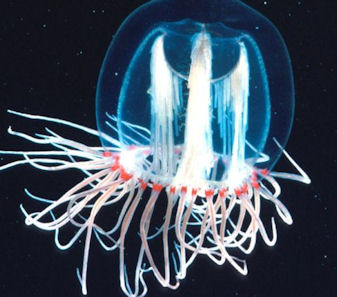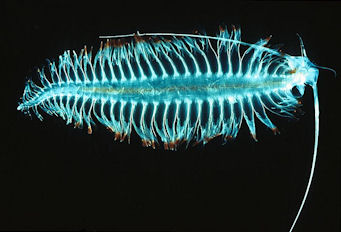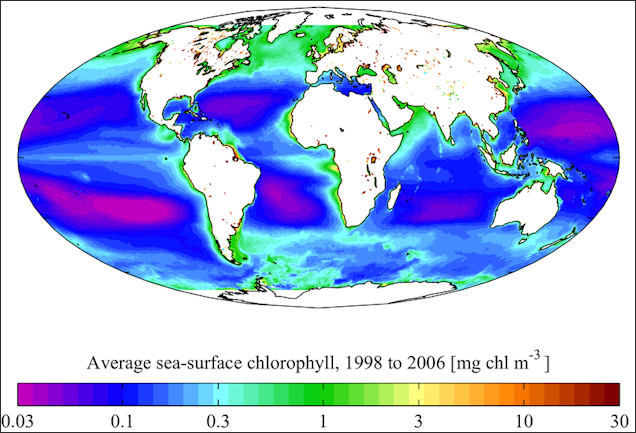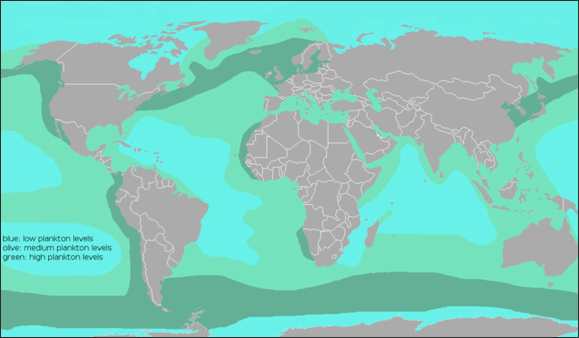Home | Category: Oceans and Sea Life
PLANKTON

zooplankton Plankton are marine drifters — organisms carried along by tides and currents. The word “plankton” comes from the Greek for “wanderer.” An organism is considered plankton if it is carried by tides and currents, and cannot swim well enough to move against these forces. Some plankton drift this way for their entire life cycle. Others are only classified as plankton when they are young, but they eventually grow large enough to swim against the currents. Plankton are usually microscopic, often less than one inch in length, but they also include larger species like some crustaceans and jellyfish.
Scientists classify plankton in several ways, including by size, type, and how long they spend drifting. But the most basic categories divide plankton into two groups: phytoplankton (plants) and zooplankton (animals). Plankton are incredibly important to the ocean ecosystem, and very sensitive to changes in their environment, including in the temperature, salinity, pH level, and nutrient concentration of the water. When there are too many of certain nutrients in the water, for instance, harmful algal blooms like red tides are the result. Because many zooplankton species eat phytoplankton, shifts in timing or abundance of phytoplankton can quickly affect zooplankton populations, which then affects species along the food chain. Researchers are studying how climate change affects plankton, from the timing of population changes to the hardening of copepod shells, and how those effects ripple through ecosystems.
Surprisingly, plankton has been found 9,145 meters (30,000 feet) in the air by research. They are believed to have been delivered there by clouds associated with hurricanes and other large storms that suck up air and other materials.
Related Articles:
OCEAN LIFE: SPECIES, BIODIVERSITY, OLDEST AND MOST NUMEROUS ioa.factsanddetails.com
STROMATOLITES, THROMBOLITES AND THE WORLD'S OLDEST LIFE FORMS ioa.factsanddetails.com
CAMBRIAN EXPLOSION AND THE WORLD'S OLDEST ANIMALS ioa.factsanddetails.com
DEEP SEA LIFE: IN THE DEEPEST TRENCHES, AROUND VENTS, NEW SPECIES ioa.factsanddetails.com
BIOLUMINESCENCE IN THE SEA: WHY, HOW AND CREATURES THAT USE IT ioa.factsanddetails.com
SEAWEED: FOOD, HEALTH, FARMING AND CLIMATE CHANGE ioa.factsanddetails.com
STUDYING OCEAN LIFE: TAGGING, TELEMETRY, CENSUSES AND TOPP ioa.factsanddetails.com
Websites and Resources: Animal Diversity Web (ADW) animaldiversity.org; National Oceanic and Atmospheric Administration (NOAA) noaa.gov; “Introduction to Physical Oceanography” by Robert Stewart , Texas A&M University, 2008 uv.es/hegigui/Kasper ; Fishbase fishbase.se ; Encyclopedia of Life eol.org ; Smithsonian Oceans Portal ocean.si.edu/ocean-life-ecosystems ; Woods Hole Oceanographic Institute whoi.edu ; Cousteau Society cousteau.org ; Monterey Bay Aquarium montereybayaquarium.org ; MarineBio marinebio.org/oceans/creatures
RECOMMENDED BOOKS:
“Strange Sea Creatures Hardcover” by Erich Hoyt Amazon.com
“The Extreme Life of the Sea”“ by Stephen and Anthony Palumbi, Princeton University Press (2014) Amazon.com
“Biological Oceanography” by Charles B. Miller (2004) Amazon.com
“Biological Oceanography: An Introduction” by Timothy R. Parsons (1993) Amazon.com
“The Marine World: A Natural History of Ocean Life” by Frances Dipper (2016) Amazon.com
“Marine Biology For The Non-Biologist” by Andrew Caine Amazon.com
“Introduction to the Biology of Marine Life:” by John Morrissey, James L. Sumich Amazon.com
“Dive into the Ocean: Exploring Different Types of Sea Life” by Shane McAleer , Cameron McAleer, et al. (2023) Amazon.com
“The Soul of an Octopus: A Surprising Exploration into the Wonder of Consciousness” by Sy Montgomery (2015), a book about marine biology, with an emphasis on the intelligence and consciousness of octopuses. Amazon.com
“Ocean, New Edition (DK Definitive Visual Encyclopedias)” Amazon.com
“Oceanology: The Secrets of the Sea Revealed” (DK Secret World Encyclopedias) Amazon.com
“The Unnatural History of the Sea” by Callum Roberts (Island Press (2009) Amazon.com
“Ocean: The World's Last Wilderness Revealed” by Robert Dinwiddie , Philip Eales, et al. (2008) Amazon.com
“The Sea Around Us” by Rachel Carson, an influential work that highlights the importance of ocean conservation (1950) Amazon.com
“The Life & Love of the Sea” by Lewis Blackwell Amazon.com
“Blue Hope: Exploring and Caring for Earth's Magnificent Ocean” by Sylvia Earle (2014) Amazon.com
“National Geographic Ocean: A Global Odyssey” by Sylvia Earle (2021) Amazon.com
Phytoplankton
Phytoplankton are microscopic plants, but they play a huge role in the marine food web. Like plants on land, phytoplankton perform photosynthesis to convert the sun’s rays into energy to support them, and they take in carbon dioxide and produce oxygen. Because they need the sun’s energy, phytoplankton are found near the water’s surface. The term phytoplankton is derived from the Greek words for "wandering plant".
Phytoplankton is the base of several aquatic food webs. In a balanced ecosystem, they provide food for a wide range of sea creatures. Single-cell bacteria and phytoplankton are the basis for all marine life. Without them the seas and the land would be sterile. A cubic meter of sea water may contain millions of phytoplankton, which drift through the water, deriving nutrition from sea water minerals and sunshine and transform mineral into vegetable nutrients (themselves) that can be consumed by other microscopic creatures.
The two main classes of phytoplankton are dinoflagellates and diatoms. Dinoflagellates use a whip-like tail, or flagella, to move through the water and their bodies are covered with complex shells. Diatoms also have shells, but they are made of a different substance and their structure is rigid and made of interlocking parts. Diatoms do not rely on flagella to move through the water and instead rely on ocean currents to travel through the water.
Microalgae and Algae Blooms
Phytoplankton are mostly microscopic single-cell marine algae. They are is similar to terrestrial plants in that they contain chlorophyll and require sunlight in order to live and grow. Most marine algae are buoyant and float in the upper part of the ocean, where sunlight penetrates the water. Phytoplankton also require inorganic nutrients such as nitrates, phosphates, and sulfur which they convert into proteins, fats, and carbohydrates.
The largest algae is about a millimeter across and the smallest is about 1/50th of a millimeter across. Their bodies are encased in shells made of calcium carbonate and to a lesser extent silica. These shells come a wide variety of intricate shapes comprised of spears, radiating spines, prongs and lattices. Many of these are diatoms.

Phytoplankton swirls Year after year, over vast areas in the open sea, phytoplankton blooms, providing vast amounts of food for a large number of creatures. Like vast grasslands, these blooms are feed by nutrients provided by the droppings and dead bodies of sea creatures. These nutrient sinks and are brought to the surface by ocean-churning storms, currents and upwelling. When the nutrients give out the blooms stop. When the blooms become too large they suck up oxygen and kill water life.
In a balanced ecosystem, phytoplankton provide food for a wide range of sea creatures including shrimp, snails, and jellyfish. When too many nutrients are available, phytoplankton may grow out of control and form harmful algal blooms (HABs), also known as red tide. These blooms can produce extremely toxic compounds that have harmful effects on fish, shellfish, mammals, birds, and even people.
The National Centers for Coastal Ocean Science conduct extensive research on harmful algal blooms. Scientists use a range of technologies to predict where and when HABs are likely to form and how they will affect the areas where they occur. Scientists use this information to inform coastal authorities on how to best respond in order to minimize negative impacts.
See Separate Article on RED TIDES
Phytoplankton, Satellites, the Environment and Climate Change
Phytoplankton are generally smaller than the size of a and pinhead and contain the green pigment chlorophyll. All plants (on land and in the ocean) use chlorophyll to capture energy from the sun and through the process known as photosynthesis convert water and carbon dioxide into new plant material and oxygen. [Source: NASA]
Although microscopic, phytoplankton can bloom in such large numbers that they can change the color of the ocean to such a degree that we can measure that change from space. The green pigment of chlorophyll preferentially absorb the red and blue portions of the light spectrum (for photosynthesis) and reflect green light. So, the ocean over regions with high concentrations of phytoplankton will appear as certain shades, from blue-green to green, depending upon the type and density of the phytoplankton population.
The basic principle behind the remote sensing of ocean color from space using satellites is this: the more phytoplankton in the water, the greener it is....the less phytoplankton, the bluer it is.The study of ocean color helps scientists gain a better understanding of phytoplankton and their impact on the Earth system. These small organisms can affect a system on a very large scale such as climate change.

zooplankton Phytoplankton use carbon dioxide for photosynthesis and in turn provide almost half the oxygen we breathe. The larger the world's phytoplankton population, the more carbon dioxide gets pulled from the atmosphere, hence, the lower the average temperature due to lower volumes of this greenhouse gas. Scientists have found that a given population of phytoplankton can double its numbers about once per day. In other words, phytoplankton respond very rapidly to changes in their environment. Large populations of these organisms, sustained over long periods of time, could significantly lower atmospheric carbon dioxide levels and, in turn, lower average temperatures. Carbon can be 'stored' in oceanic sediments when organic matter sinks and is buried in the ocean floor.
Understanding and monitoring phytoplankton can help scientists study and predict environmental change. Since phytoplankton depend upon sunlight, water, and nutrients to survive, physical or chemical variance in any of these ingredients over time for a given region will affect the phytoplankton concentrations. Phytoplankton populations grow or diminish rapidly in response to changes in its environment. Changes in the trends for a given phytoplankton population, such as its density, distribution, and rate of population growth or diminishment, will alert Earth scientists that environmental conditions are changing there. Then, by comparing these phytoplankton trends to other measurements - such as temperature - scientists can learn more about how phytoplankton may be contributing to, and affected by, climatic and environmental change.
Zooplankton
Zooplankton are small animals, many which consist of a single cell. They can't produce food through photosynthesis and instead feed themselves be consuming phytoplankton. Zooplankton include microscopic animals (krill, sea snails, pelagic worms, etc.), the young of larger invertebrates and fish, and weak swimmers like jellyfish.
Most zooplankton eat phytoplankton, and most are, in turn, eaten by larger animals (or by each other). Krill may be the most well-known type of zooplankton; they are a major component of the diet of humpback, right, and blue whales. During the daylight hours, zooplankton generally drift in deeper waters to avoid predators. But at night, these microscopic creatures venture up to the surface to feed on phytoplankton. This process is considered the largest migration on Earth; so many animals make this journey that it can be observed from space.
Floating forms of life include transparent worms, jellyfish, flatworms, shrimp, swimming crabs, the larvae of crabs, worms, starfish and mollusks. All of these creatures are regarded as plankton and they feed on other kinds of plankton or themselves and provide for larger creatures.
Copepods
Copepods are flealike creatures and one of the most abundant and diverse animal groups on Earth. One sampling of an area the size of a bathroom (5.4 square meters) deep in the South Atlantic Ocean in the mid 2000s turned up 700 species of copepod, 99 percent of them unknown to science. Many copepods are considered zooplankton and are fed on by a huge number and array of sea creatures, most of who are fed on by larger sea creatures. In this way copepods are one of the foundations of the food chain.
Copepods (meaning "oar-feet") are found in nearly every freshwater and saltwater habitat. Some species are planktonic (inhabiting sea waters); some are benthic (living on the ocean floor); a number of species have parasitic phases. Some live on land in swamps, under leaf fall in wet forests, bogs, springs, puddles and water-filled recesses of plants such as bromeliads and pitcher plants. Many live underground in marine and freshwater caves. Copepods are sometimes used as biodiversity indicators. [Source: Wikipedia +]
Copepods are related to shrimp and crabs. They are an important planktonic food source for most of the world's fish species. This high predation pressure has led copepods to evolve extremely fast escape responses when a predator is sensed, and can jump with high speed over a few millimeter. Reaction times to hydrodynamic disturbances of less than 4 milliseconds (thousandths of a second) and escape speeds of over 500 body lengths per second have been measured using 3D high speed digital holographic cinematography (up to 2000 frames per second), [Source: Project Seahorse]
About 13,000 species of copepods are known. As with other crustaceans, copepods go through a larval stage. For copepods, the egg hatches into a nauplius form, with a head and a tail but no true thorax or abdomen. The larva molts several times until it resembles the adult and then, after more molts, achieves adult development. The nauplius form is so different from the adult form that it was once thought to be a separate species. +
Copepods vary considerably, but are typically 1 to 2 millimeters (1∕32 to 3∕32 inches) long, with a teardrop-shaped body and large antennae. Like other crustaceans, they have an armoured exoskeleton, but they are so small that in most species, this thin armour and the entire body is almost totally transparent. Because of their small size, copepods have no need of any heart or circulatory system (one Calanoida has a heart, but no blood vessels), and most also lack gills. Instead, they absorb oxygen directly into their bodies. Most free-living copepods feed directly on phytoplankton, catching cells individually. A single copepod can consume up to 373,000 phytoplankton per day. +
Neuston
Creatures floating on the surface of the ocean such blue dragon nudibranchs, Portuguese man-o-wars and other small animals are collectively known as neuston. Little is known about neuston that are found far from land in the open sea. “They are very difficult to study because they occur in the open ocean and you cannot collect them unless you go on marine expeditions, which cost a lot of money,” Lanna Cheng, a research scientist at the University of California, San Diego, told the New York Times. Because of this any information about them is considered valuable. [Source: Annie Roth, New York Times, May 7, 2022]
Neuston are also known as pleuston. They can be found at the surface of estuaries, lakes and rivers as well as the sea and can live on top of the water surface, attached to the underside of the water surface or in the surface microlayer that forms between the top side and the underside. The word neuston comes from the Greek neustos, meaning "swimming". The term first appeared in the biological literature in 1917. The term pleuston comes from the Greek plein, meaning "to sail or float". It was first used 1909. There is some debate as to whether the two terms are the same or slightly different. As of 2021, the two terms are usually used somewhat interchangeably, and neuston is used more often than pleuston. [Source: Wikipedia]
There are different ways of categorizing neuston. Some scientists divide them by their physical position into two groups: 1) epineuston: organisms living on the water’s surface; and 2) hyponeuston: organisms within a region of specified depth directly below the surface layer. To this can be added the organisms living in the microlayer at the interface between air; and 3) microlayer neuston: organisms (microorganisms) living in the surface microlayer squeezed between the upper and under surface.
Other scientists divide neuston into three ecological categories: 1) euneuston: organisms with maximum abundance in the vicinity of the surface on which they reside day and night; 2) facultative neuston: organisms concentrating at the surface only during certain hours of the day, usually during darkness; and 3) pseudoneuston: organisms with maximum concentrations at deeper layers but reaching the surface layer at least during certain hours.
Mucous-Mesh Grazers
Kelly Sutherland wrote in Smithsonian magazine: If you’ve heard the term “grazer” before, it may bring to mind familiar farm animals, such as cows or sheep munching on pastureland. But the ocean has its own suite of grazers, with very different — even bizarre — body forms and feeding techniques. Instead of teeth, one group of these invertebrates uses sheets of mucus to consume huge quantities of tiny plant-like particles...My colleagues and I suggest a new categorization for this overlooked group: “mucous-mesh grazers,” in recognition of their unusual feeding strategy. [Source: Kelly Sutherland, Assistant Professor of Biology, University of Oregon, Smithsonian magazine, May 2, 2018]
Unlike the mucus in our noses, which appears amorphous and blobby, the mucous sheets of these ocean grazers can be structured into ornate meshes and nets. These mucous sheets can function like a filter to ensnare food as small as bacteria. The grazers themselves are mammoth in comparison: up to 10,000 times bigger than their food. If people ate food that small, you’d be picking salt and sugar grains off your dinner plate. Marine biologists like me used to think mucous grazing was a “catch-all” feeding strategy — the idea was these guys would just chow down on whatever their mucous sheet caught. But recent technological advances are helping us understand that mucous grazers can be picky eaters. And what they consume — or don’t — influences ocean food webs.
Mucous-mesh grazers include salps, pyrosomes, doliolids, pteropods and appendicularians. They are typically centimeters in length, roughly spanning the size of your fingernail to the size of your hand. Some form colonies comprised of many individuals in long chains that can be much longer. These creatures are large and watery compared to their hard-bodied planktonic counterparts. If you stepped on one, it would squish, not crunch. A mostly water body enables them to grow large quickly.
Mucous-mesh grazers are free floating and suited to the open ocean. They live far from shore, where food is scarce and often small. The tiny holes and fibers of their mucous meshes enable them to capture microscopic particles, which they subsequently swallow, sometimes along with the mucus.

How Mucous-Mesh Grazing Works
Kelly Sutherland wrote in Smithsonian magazine: Mucous-mesh grazers grazers have a special organ, called an endostyle, that secretes their mucous mesh. Depending on the grazer, the mucous mesh can be located either inside or outside the body. One group, for example, secretes a mucous bubble big enough for the animal to live inside like a house. Another group, nicknamed sea butterflies, secrete mucous webs that attach to their wing-shaped feet. These mucous webs range in size from an inch to over 6 feet. [Source: Kelly Sutherland, Assistant Professor of Biology, University of Oregon, Smithsonian magazine, May 2, 2018]
Historically, scientists assumed mucous-mesh grazers ate anything that passed through the mucous sieve — similar to a strainer in the drain of the kitchen sink catching everything of a certain size that flows in. Recent research by my lab and others challenges this assumption and shows that their feeding may be highly selective. The mucus might capture certain food particles perfectly, while completely rejecting other particles on the basis of their size, shape or surface properties. For example, when presented with a mixture of rod-shaped and spherical food particles — differently shaped but otherwise similar in size — one species of mucous-mesh grazer preferentially swallows the spherical particles. That’s a bit like choosing tater tots over French fries: They’re both made of potatoes and are roughly the same size but they have different shapes. The mucous grazers’ food “choice” is passive, though, having to do with how differently shaped prey orient in seawater and intercept the mesh.
Grazers can “pick” prey, but prey may also be able to have some say in the matter — either passively or actively. For instance, some bacteria have Teflon-like surfaces and don’t stick to the mucous meshes, so they’re almost never consumed. How all of the different prey properties might influence grazing has been underappreciated until recently.
The fact that they don’t capture all prey equally has important consequences for how carbon moves through the ocean. After mucous grazers feed, they package undigested food particles into mucus-bound fecal pellets or other castoff material. Repackaging prey particles with sticky mucus concentrates small prey into larger aggregates, which makes them sink more quickly. This ultimately moves organic material to the ocean depths, potentially storing it for years or even centuries. At depth, this material is unavailable to the majority of marine organisms that live near the surface.

World plankton prevailence
Until the past decade or two, scientists didn’t have technological tools to watch what was happening with mucous-mesh grazers in their native habitat at the appropriate tiny scales. Because these organisms are quite fragile, now researchers in my lab and others use scuba diving or robots to directly observe them underwater. These close, careful observations using high-speed cameras and underwater microscopes or doing feeding studies in the natural environment have shown us how they select certain particles and reject others.
Extremophiles
Extremophiles are organisms that live in "extreme environments," under high pressure and temperature. Bacteria often form on the rocks near the hydrothermal vents. They have the ability to thrive in what is normally considered very harsh environments and such as hydrothermal vents and among other things they can tell us under which range of conditions life is possible.
Unique enzymes used by these organisms, called "extremozymes," enable these organisms to function in such forbidding environments. These creatures hold great promise for genetically based medications and industrial chemicals and processes. It's important to note that these organisms are 'extreme' only from a human perspective. While oxygen, for example, is a necessity for life as we know it, some organisms flourish in environments with no oxygen at all.
Pompeii worms live near deep sea vents. Their tails can tolerate near boiling hot temperatures while their heads, just a few centimeters away, are adapted to deep-sea cold. Scientists thinks their circulate fluids through their bodies “like a natural heat pump.”
Elizabeth Kolbert wrote in The New Yorker: “Some of the seas’ most extraordinary animals live around hydrothermal vents — the oceanic equivalents of hot springs. Through cracks in the seafloor, water comes in contact with the earth’s magma; the process leaves it superheated and loaded with dissolved minerals. (At some vents, the water reaches a temperature of more than seven hundred degrees.) [Source: Elizabeth Kolbert, The New Yorker, June 14, 2021]
Helen Scales, a British marine biologist, explains in her new book, “The Brilliant Abyss” “these animals” turned out to be fundamentally different from other creatures. At the bottom of the vents’ food chains are microbes that have come up with their own novel survival strategy. Instead of using photosynthesis, which harnesses the energy of photons, they rely on chemosynthesis, which uses the energy stored in chemical bonds. Since the late nineteen-seventies, Scales reports, researchers have catalogued hundreds of strange species living around vents; they include creatures so puzzling that it’s hard to find a limb for them on the tree of life.
Image Sources: Wikimedia Commons; YouTube, Animal Diversity Web, NOAA
Text Sources: Animal Diversity Web (ADW) animaldiversity.org; National Oceanic and Atmospheric Administration (NOAA) noaa.gov; Wikipedia, National Geographic, Live Science, BBC, Smithsonian, New York Times, Washington Post, Los Angeles Times, The New Yorker, Reuters, Associated Press, Lonely Planet Guides and various books and other publications.
Last Updated April 2023




